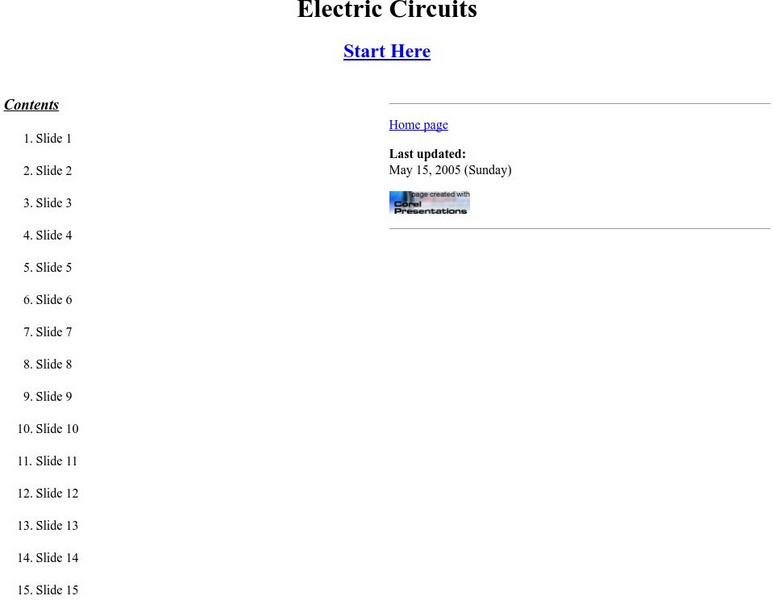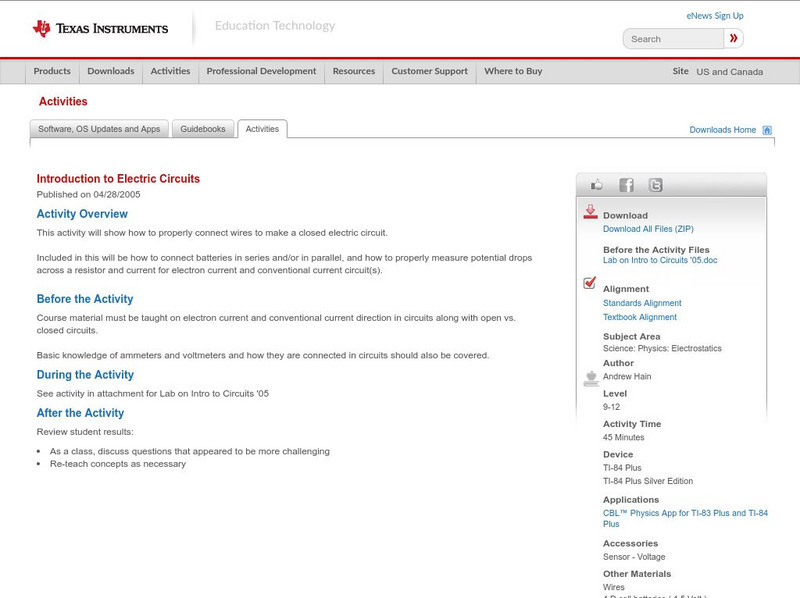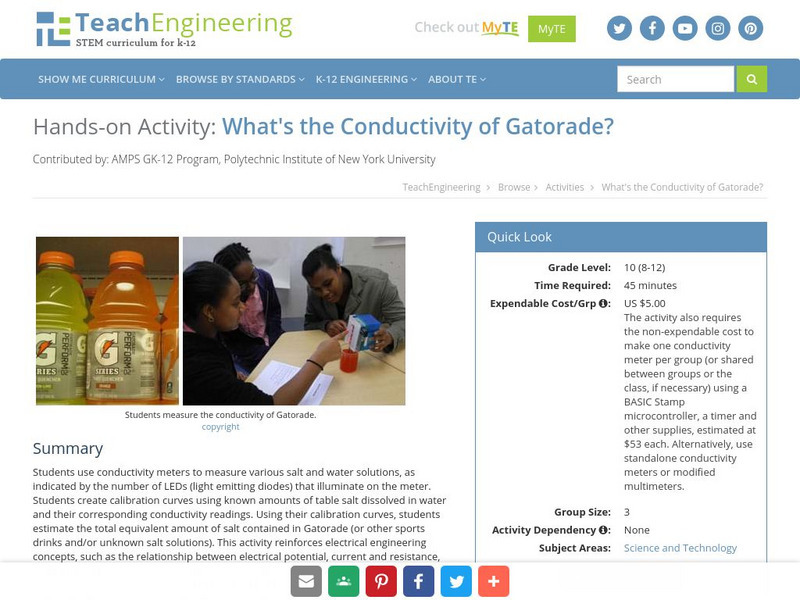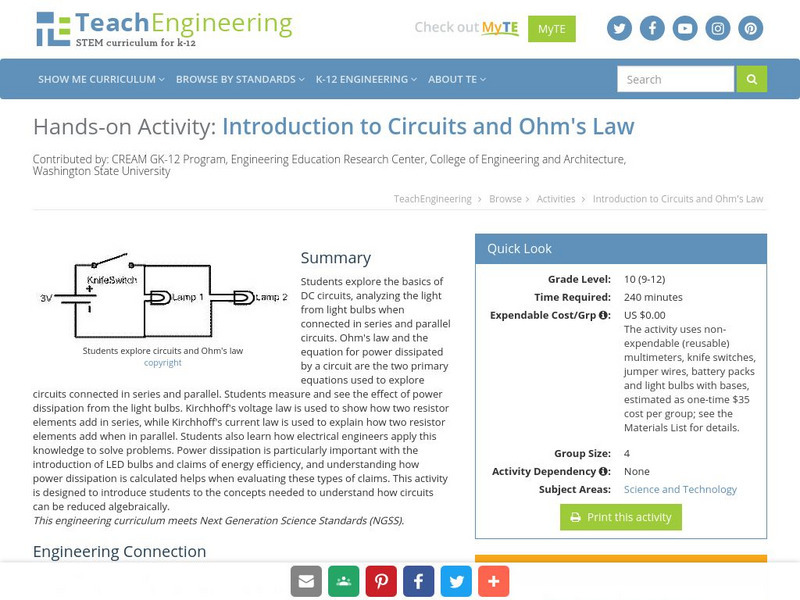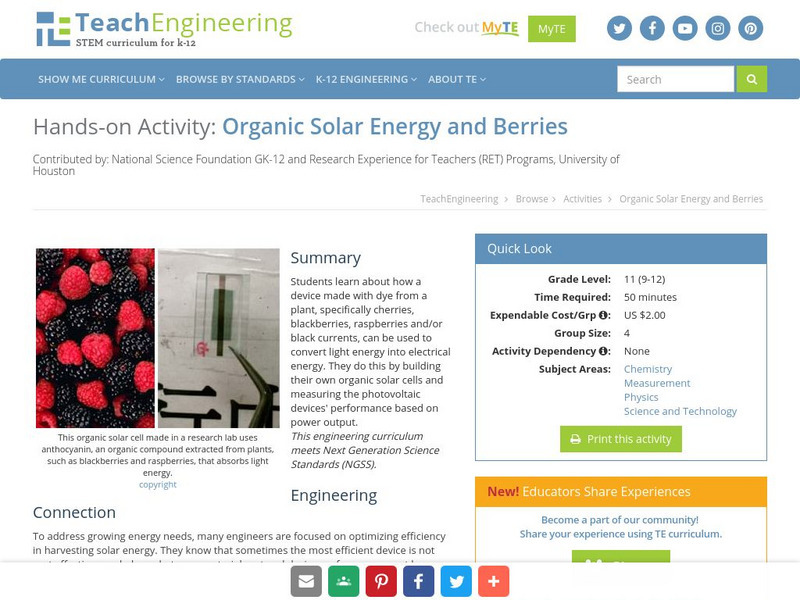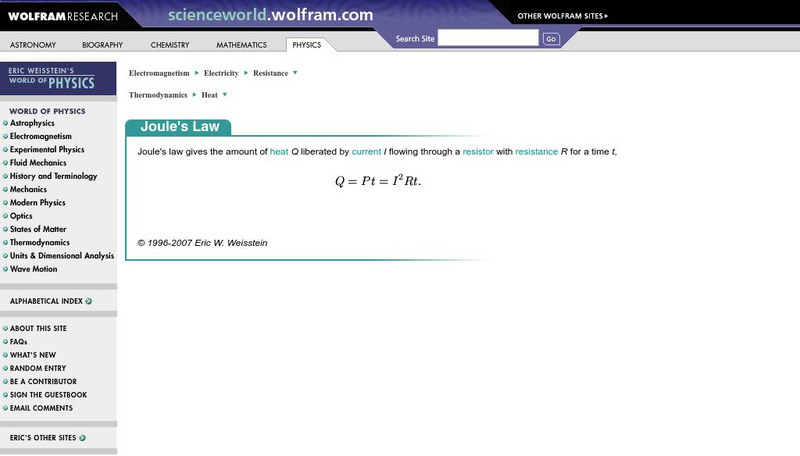Other
Beginner's Guide to Measurement in Electronic and Electrical Engineering [Pdf]
The National Physical Laboratory, which is the UK's National Measurement Institute, offers a Beginner's Guide to Measurements in Electronics and Electrical Engineering. Discusses how electric currents are measured and offers images.
Other
Need: Measuring Electricity [Pdf]
This site details many of the ways in which to measure electricity. Among the topics covered by this page is resistance and voltage as well as electrical energy and Ohm's Law.
CK-12 Foundation
Ck 12: Measuring Current and Voltage
[Free Registration/Login may be required to access all resource tools.] Students are introduced to the ammeter, which measures electrical current, and to the voltmeter, which measures voltage.
Khan Academy
Khan Academy: Electrical Engineering: Introduction
Some basic concepts to introduce the electrical engineering course. Become familiar with engineering numbers and notation, and learn about the two most important electrical quantities: current and voltage.
BBC
Bbc: Gcse Bitesize: Electric Circuits
Current transfers energy around circuits. Circuit components have various properties that can be measured and then used to make circuits for control and also circuits for testing other components.
Upper Canada District School Board
Tom Stretton's Chemistry Pages: Electric Circuits
Learn the voltage formula for determining a measure of current electricity in this illustrated presentation.
Concord Consortium
Concord Consortium: Calculating Current in Series Parallel Circuits
Use resistance formulas to determine the total resistances of the series and parallel parts. Then, use Ohm's Law to calculate the voltage drops across and currents through each part.
University of Colorado
University of Colorado: Ph Et Interactive Simulations: Circuit Construction Kit
Build circuits with resistors, light bulbs, batteries, and switches. Take measurements with the realistic ammeter and voltmeter. View the circuit as a schematic diagram, or switch to a life-like view.
Texas Instruments
Texas Instruments: Introduction to Electric Circuits
This activity will show how to properly connect wires to make a closed electric circuit. Included in this will be how to connect batteries in series and/or in parallel, and how to properly measure potential drops across a resistor and...
Khan Academy
Khan Academy: Using Voltmeters & Ammeters to Measure Potential Diff and Current
Practice identifying the correct placement of voltmeters and ammeters to measure an unknown circuit or electric potential difference for a circuit.
Ducksters
Ducksters: Kids Science: Electricity 102
Kid's learn more about the science of electricity. How its measured and generated.
TeachEngineering
Teach Engineering: What's the Conductivity of Gatorade?
Students use conductivity meters to measure various salt and water solutions, as indicated by the number of LEDs (light emitting diodes) that illuminate on the meter. Students create calibration curves using known amounts of table salt...
TeachEngineering
Teach Engineering: Pointing at Maximum Power for Pv
Student teams measure voltage and current in order to determine the power output of a photovoltaic (PV) panel. They vary the resistance in a simple circuit connected to the panel to demonstrate the effects on voltage, current, and power...
TeachEngineering
Teach Engineering: Introduction to Circuits and Ohm's Law
Students will explore the basics of dc circuits analyzing the light from light bulbs when connected in series and parallel circuits. Ohm's Law and the equation for power dissipated by a circuit will be the primary equations used. Using...
TeachEngineering
Teach Engineering: Sensing Air Pollution
Students learn about electricity and air pollution while building devices to measure volatile organic compounds (VOC) by attaching VOC sensors to prototyping boards. In the second part of the activity, students evaluate the impact of...
TeachEngineering
Teach Engineering: Organic Solar Energy and Berries
Students learn about how a device made with dye from a plant, specifically cherries, blackberries, raspberries and/or black currents, can be used to convert light energy into electrical energy. They do this by building their own organic...
TeachEngineering
Teach Engineering: Power Your House With Water
Students learn how engineers design devices that use water to generate electricity by building model water turbines and measuring the resulting current produced in a motor. Students work through the engineering design process to build...
Texas Instruments
Texas Instruments: The Magnetic Field in a Slinky
Students use a Magnetic Field Sensor to measure the magnetic field and the current in a solenoid. They explore factors that affect the magnetic field, study how the field varies in parts of the solenoid, and determine the permeability...
Concord Consortium
Concord Consortium: Calculating Voltage in Series Parallel Circuits
Use the series and parallel resistance formulas to determine the total resistances of the parts. Then, use Ohm's Law to calculate the voltage drops across each part.
Wolfram Research
Wolfram Science World: Joule's Law
This site briefly defines Joule's Law. A formula is provided and links to related terms.
TeachEngineering
Teach Engineering: Dams
Through eight lessons, students are introduced to many facets of dams, including their basic components, the common types (all designed to resist strong forces), their primary benefits (electricity generation, water supply, flood...
![Beginner's Guide to Measurement in Electronic and Electrical Engineering [Pdf] Handout Beginner's Guide to Measurement in Electronic and Electrical Engineering [Pdf] Handout](https://d15y2dacu3jp90.cloudfront.net/images/attachment_defaults/resource/large/FPO-knovation.png)



